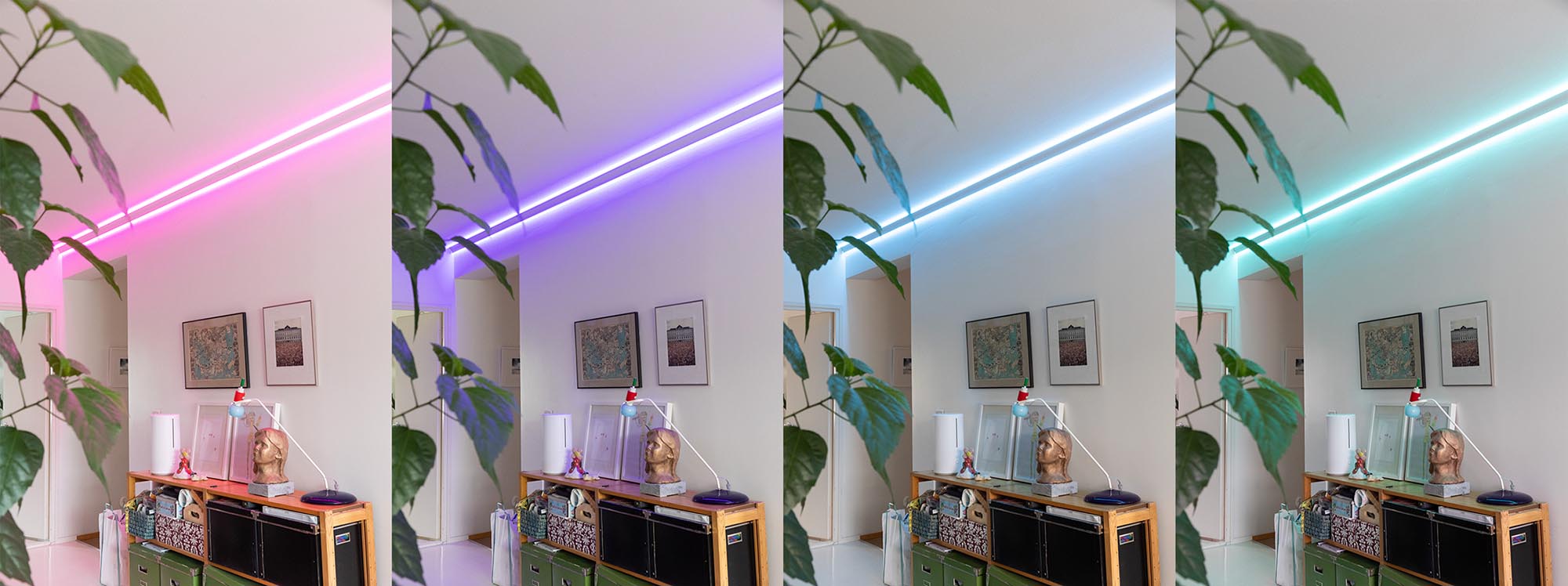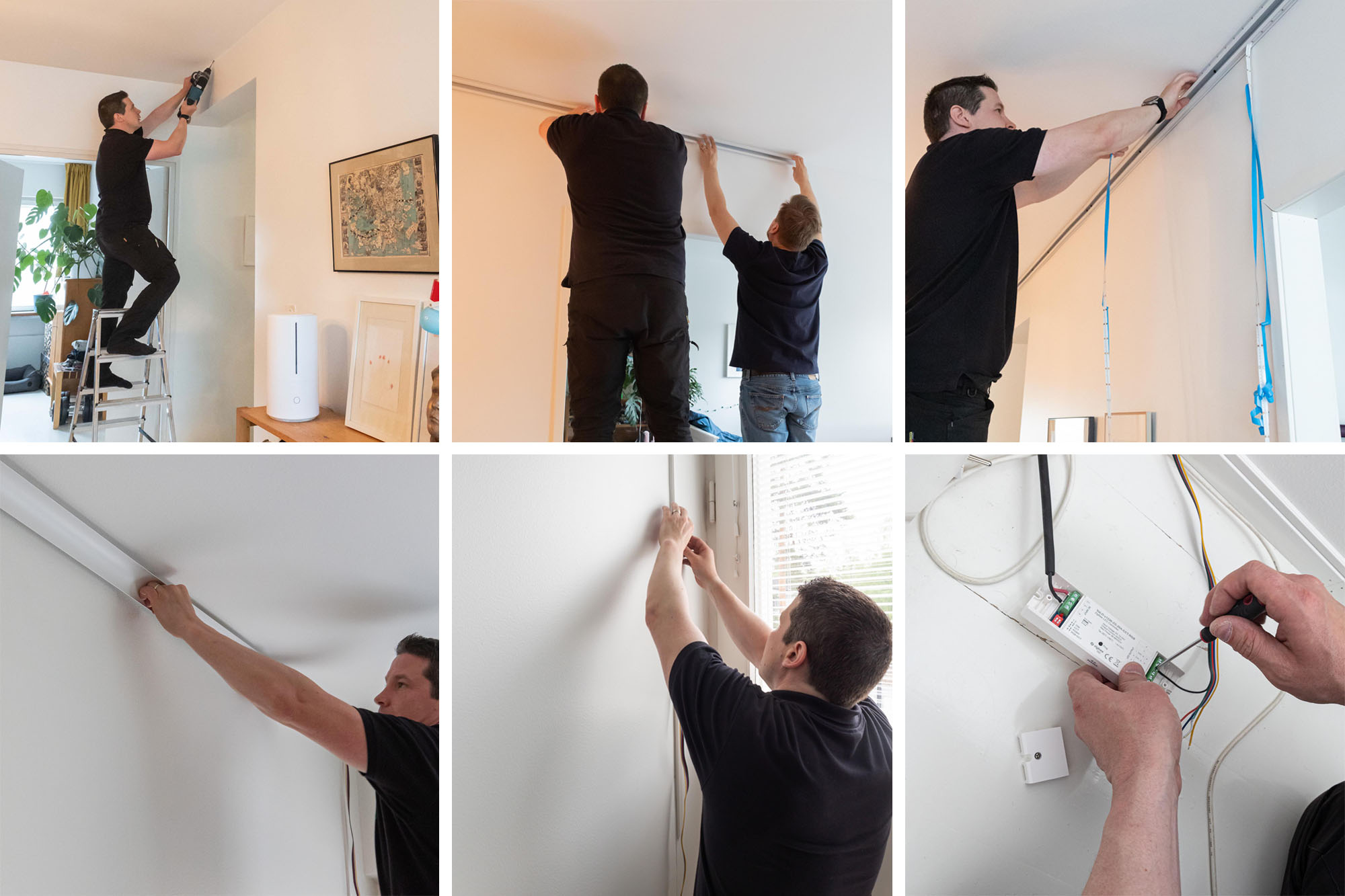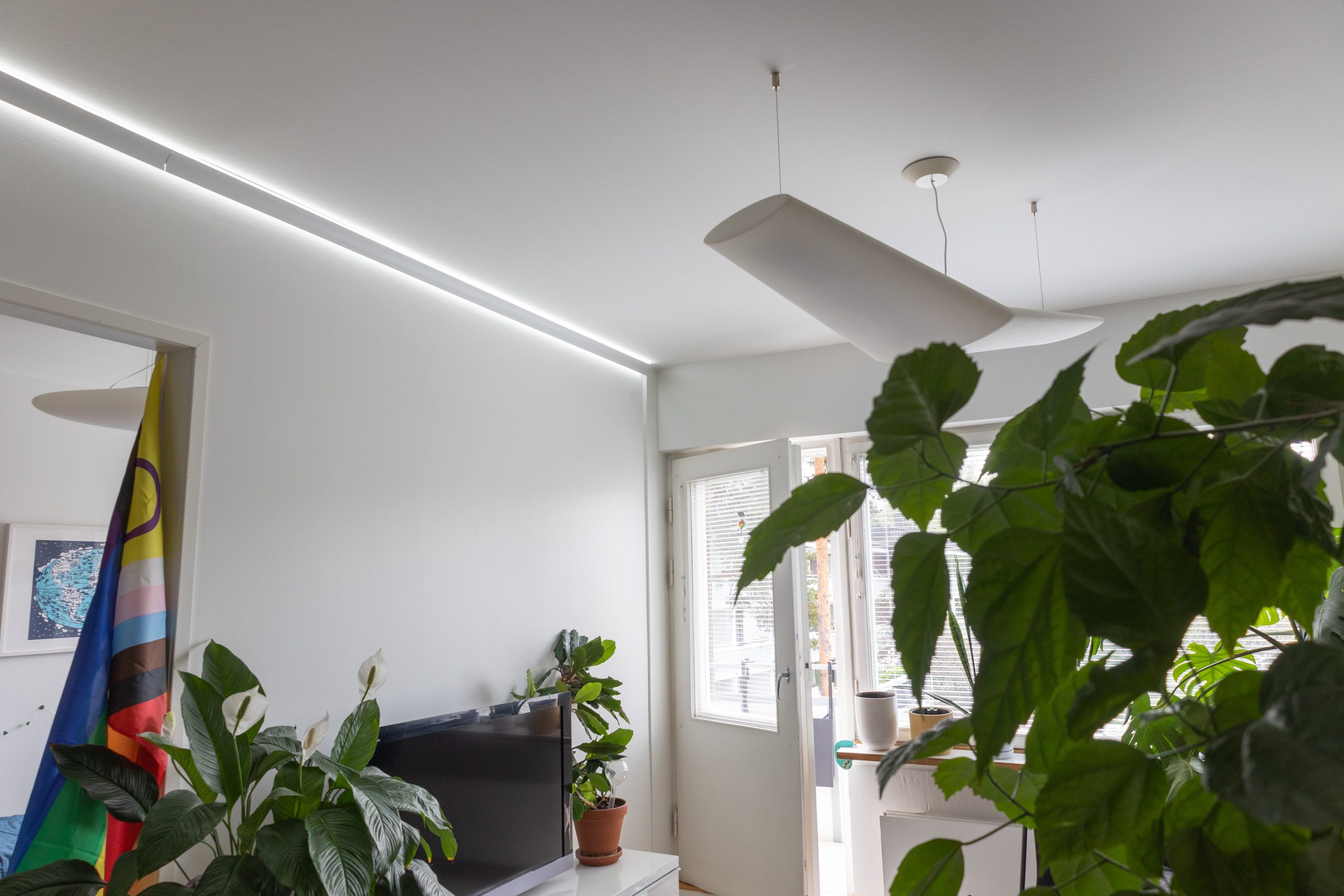We live in an apartment building built in the 1960s, so there are only two places for the ceiling lights in the living room of our apartment. So the living room is relatively deep and it seems that especially the other end of the living room is very dark, especially in winter. Initially, we thought about installing spotlights in the living room, for more efficient lighting. However, the room height in the apartment is relatively low, so lowering the ceilings further did not seem a sensible option. The alternative was to install a ribbon in the living room.
Efficient and comfortable lighting for your living room
We decided that the best solution for our situation would be a full-length LED strip installation. We were hoping to control the tape wirelessly, as the product comes as a retrofit and we have no intention of renovating the apartment at the moment, as the previous renovation was completed about five years ago. Wireless buttons avoid spaghetti wiring and allow you to control the colour temperature and dimming of your luminaires.
RGB+CCT led ribbon
The LED strip chosen was RGB+CCT LED strip, which allows the strip to produce different shades of white from warm to cold (CCT 2500K-6500K) and different colours (RGB). We chose this led tape because of its versatility. We wanted the white from the strip to have a good colour rendering (CRI 98) and to be able to provide warm white light in addition to the neutral (4000K) white for an evening “twilight glow”. In RGB+W strips, getting this warmer light clean is a challenge, as it is usually a combination of 4000K white and amber LEDs. I think a more beautiful warm white light is achieved with CCT LEDs.


Indirect-3 curved profile

Of the profiles, we chose an arc profile that gives light in the direction of the edge. The light is directed from the profile along the wall and ceiling and the installation is therefore made at the junction of the wall and ceiling. One of the reasons we chose this profile was that we wanted the solution to have a high light output, which was achieved thanks to the fact that the profile comes with two strips.
We have a profile that runs the length of the living room, so it’s about 7.3m long. The installation consists of three profiles mounted on the bush. The profiles come in 2,52m and can be shortened to a suitable length. There are two mounting points for the strips in the profile, both with white diffusers to even out the light. If the finished length of the profile exceeds 2.52m, the strips can only be fixed in place once the profile has been fixed to the wall.
The surface profile is a beautiful matt white and the surface resembles a sandblasted material. The profile should be fixed to the wall by drilling from the corner. The profile arch is removed for the duration of the fixing. The arch is fixed in place by pressing it back into the profile.
Zigbee wireless lighting control
For CCT+RGB tape control, RF or Zigbee devices are used. We chose Zigbee because we are thinking of getting a bridge (e.g. Philips HUE) to control the lighting with mobile devices later on. Currently, the luminaire is controlled by a wireless CCT+RGB control button, which was paired with a 24V Zigbee receiver. The receiver was installed between the 240W 24V IP 65 transformer and the led strips and paired with a wireless button. So 230V transformer -> receiver -> led strip.
If you want to time and program the light or use it on a mobile device, you also need a Zigbee bridge or hub, such as Philips Hue, Samsung Smart Things or Conbee2, which can be controlled by e.g. Home assistilla. Home assistant can be used to control many other things besides lights, such as cameras, thermostats and can be loaded with a The choice depends on how precisely you want to control the light, for example. whether we want the lights to match the circadian rhythm. More information about circadian rhythm in English.
In addition to this luminaire, our idea is to control the other luminaires in our apartment as we make small upgrades to them. We plan to purchase CCT adjustable bulbs and 230V receivers for light control.
Tape installation in the living room
Although it is possible to install 24V products, which are manufactured as plug-in products, we decided to buy the installation for the luminaire to save our time and nerves. The installation took about three hours, part of which was spent aligning and adjusting the profiles due to our slightly curved wall. In the pictures below, I explain the installation steps and other things to consider.

1. Product selection.
When selecting the products, we took precise measurements of the installation site, because we knew that we wanted the products to be made to a certain size, ready-made at LedPaja. We chose the products based on our requirements, which were colour control (RGB), colour temperature control (CCT), spotless light and a good colour rendering index. We also wanted the light to be efficient enough for supplementary lighting.
2. Making the ribbon and profiles to finished dimensions in LedPaja.
In this project, LedPaja drilled holes in the profiles ready for installation. The strips and profiles were made to the given dimensions. The Led strips were also connected together to make it possible to have only one wire coming from the profile to the transformer instead of two. This step can also be done by a clever solderer, but it is indeed worth noting that the small strip is soldered to a six-conductor cable. The strips were pre-glued to one 2.52m profile and the rest of the strips were left on the coil to wait to be glued to the profile once all the profiles were attached to the ceiling. This was also to finish the headboard neatly. A plug was also pre-installed in the transformer.
3. The installer arrives on site and checks the products.
We only needed one installer, because my husband and I were assisting the installer when the profile was being fitted to the ceiling. As the profiles are 2.52m long, two people are needed at a certain stage of the installation if you want the installation to proceed quickly. The Led strips were tested before the installation started, in case any of the products had failed during transport.
4. Drilling holes in the wall, where the pre-drilled holes in the profile are.
The profile hole locations were marked on the wall and holes were drilled. Props were put in the holes to make the installation strong. The fixing method depends on the wall material.
5. Fixing the profile to the drilled and tapped holes.
During this installation phase, helping hands were needed to ensure that the installer could hold the profile in place during the fixing process. This is especially important for installations over 2.52m where the profiles are installed in the bush.
6. Fixing the Led strips to the profiles and testing.
Once all the profiles were attached, it was time to glue the LED strips to the profiles along the entire length of the profiles. The Led strips were retested at this stage to see if any of the strips had been damaged during installation. The curved cover of the profile was also fixed at this stage. Fixing the curved profile cover requires it to be installed at the right angle and tapped into place, which requires some force and a handhold to hold the other end of the cover. As our walls were slightly curved in the typical 60s style, we had to adjust the fixing a bit (loosen some screws) and position the curved lid carefully to get the curve to fit nicely at the joints. Optimally implemented, the diffusers and arcs of the profile are positioned so that their joint points are at different points than the end points of the profiles. However, the curvature of our wall was such that this was not worthwhile.
7. Running the wires neatly from the profile to the transformer.
To run the wires down, I bought a sleek wire grab from a hardware store to match the tone of our wall. Our installer would have found a gutter, but I wanted to get it myself. As there is a post inside our living room wall that is slightly different in height from the rest of the wall, the cable duct was nicely tucked into that corner and was very unobtrusive. The wiring of the RGB+CCT led strip is flat cable and very multicoloured, so it has to be hidden somewhere to make a neat installation.
8. Wireless control pairing between the controller (Zigbee) and the receiver.
The installer paired the button and receiver for me and would have paired it if necessary, e.g. Philips HUE app. However, it is worth expressing such wishes when ordering the installation or assembly.
Read more:
Read more about our LedPaja installation service if you are interested in custom-made LED strip lighting.
Read more about our LedPaja installation service if you need help with your installation.
Led lighting expert
LedStore has been an expert in LED lighting since 2010. We have our own product design, so our products are technologically state-of-the-art.
Our focus is on luminaires with colour temperature control and high colour rendering. We do around 500 lighting designs in a year.
Remember that we are always ready to offer our help to you along the way, by email (myynti@ledstore.fi) and by phone (045 251 4510). As always, feel free to share photos of your own projects on social media at ledstore.fi at Instagram and ledstore.fi at Meta. We love to see the cool things done by our LEDs, and it also helps to provide inspiration for those who are not sure about the power and awesomeness of LEDs. Did you know that we already have over 3500 pictures of our LED installations in our gallery!
Photo gallery of Led lights:
Product gallery: Pictures of products in different installation locations
Indirect light: Indirect light in different spaces
Room-specific: Light in different rooms
References: Complete houses that have been photographed

